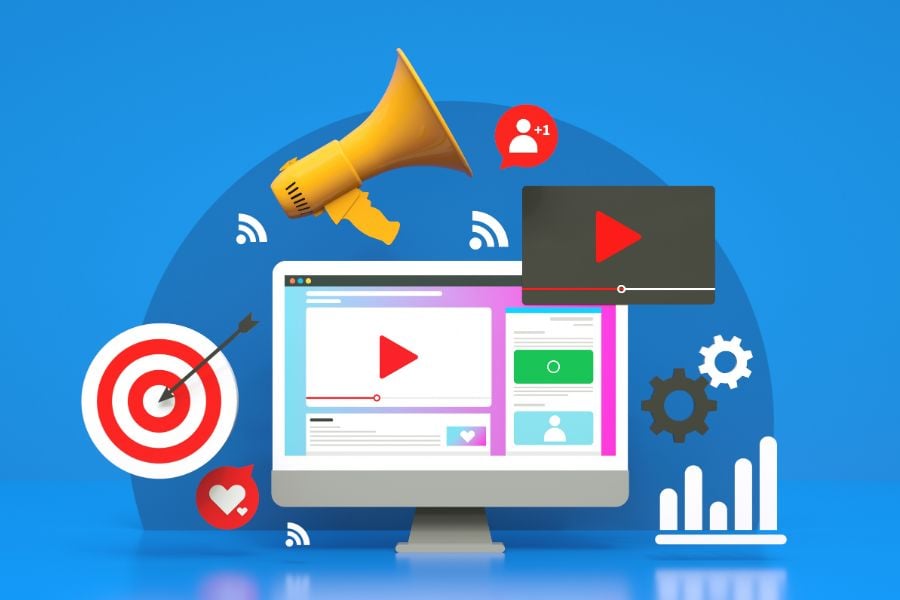You know you need a digital marketing strategy.
But you also don’t have a clue where to begin.
And when you head to Google and YouTube, you’re greeted by a lot of fluff, filler, and confusion.
In this simple guide, we’ll try to remedy that.
And we’ll begin with a simple definition…

What is a Digital Marketing Strategy?
Put simply, digital marketing strategies are a plan for reaching your business objectives through specific online marketing channels.
These channels can include owned media like your website or blog post, and earned media like customer reviews and social media mentions, or even paid media (think Google Ads).
The goal is to increase brand awareness, engage your target audience, and ultimately, convert visitors into loyal customers. And that requires a carefully thought-out plan.
Why Do You Need a Digital Marketing Strategy?

A well-crafted digital marketing strategy to an online marketer is as important as a GPS to a trucker, guiding you toward marketing success. Here’s why it’s essential:
- Direction: A solid strategy gives you clear direction. It’s your roadmap in the vast digital marketing landscape, helping you reach your desired destination — be it enhancing brand awareness, increasing traffic, or boosting sales.
- Competitive Edge: In the world of online marketing, standing still is the same as moving backward. A digital marketing strategy helps you stay ahead, keeping pace with the evolving digital trends and giving you an edge over your competition.
- Customer Engagement: A well-defined digital marketing strategy lets you connect with your potential customers where they spend most of their time — the digital world. It lets you to engage them with the right content, at the right time, through the right digital channels.
- Optimization: What’s working? What’s not? A digital marketing strategy paired with tools like Google Analytics, provides you with crucial customer insights and the ability to optimize your marketing efforts based on these data-driven findings.
- Growth: Lastly, an effective digital marketing strategy can fuel your business growth. It helps you acquire new customers, retain existing ones, and build a loyal customer base.
But, how do you create a successful digital marketing strategy that’ll skyrocket your growth?
5 Crucial Steps to Creating Your Digital Marketing Plan

Now that you’ve understood the what and why of digital marketing strategies, let’s focus on the how.
Here’s a step-by-step guide to craft your very own, custom-fit digital marketing plan…
Step 1. Understand Your Buyer Persona
A successful strategy depends on a deep understanding of your target audience.
Your first step is crafting a detailed buyer persona, or a semi-fictional representation of your ideal customer. This persona isn’t just a name or an age group, but a rich profile that captures their interests, pain points, motivations, and behaviors.
For instance, let’s say you’re a local gym owner aiming to attract more members.
Your primary target could be young professionals looking for convenient and efficient workout options. A buyer persona for this audience might be:
“Gym Joe,” a 30-year-old busy professional who values health but struggles to find time for regular workouts.
To fill out this persona, you need to dig deeper.
What type of workouts does Gym Joe prefer? Does he enjoy group classes or prefer solo training? Is he more motivated by health, appearance, or stress relief?
Unearth these nuances using customer feedback, social media interactions, surveys, and more. An authentic, richly-detailed buyer persona allows you to create tailored marketing efforts that resonate, engage, and convert more effectively.
Moreover, you can utilize various tools like HubSpot’s Make My Persona, or Google Analytics to gather more granular information about your potential customers.
Remember, the more precise your persona, the more personal and effective your marketing strategy will be.
Step 2. Define Your Digital Marketing Goals

Now that you have a vivid picture of your target audience in mind, it’s time to define your digital marketing goals.
Keep in mind: these goals can’t be generic or vague.
They need to be SMART — Specific, Measurable, Achievable, Relevant, and Time-bound.
For example, let’s say you run a small online bakery. Instead of a general goal like “increase sales,” opt for a SMART goal like:
“Increase online sales by 20% over the next three months through social media marketing and email newsletters.”
Why is a SMART goal beneficial? Because it provides clarity.
It pinpoints exactly what you want to achieve, how you will measure success, and by when you intend to reach it. This precise focus not only makes your goal more realistic but also makes sure everyone on your team understands what they’re working for.
Remember, without clear goals, your marketing strategy is like a ship lost at sea.
By setting SMART goals, you create a roadmap for your marketing efforts, making sure everyone is moving in the right direction.
And here’s a bonus tip: Consider using tools (such as Trello) to track your progress and keep your team aligned.
Step 3. Choose the Right Digital Marketing Channels

Here’s a secret: You don’t need to be everywhere, just where your customers are. This is a rule of thumb in digital marketing.
You might be tempted to create a profile on every possible platform, but your efforts will yield better results if you focus on the channels where your target audience frequents.
Let’s start by breaking down the main categories of digital channels:
Each has its unique advantages, audience, and communication style.
Social media platforms, such as Instagram, Facebook, LinkedIn, or Twitter, are ideal for creating conversations and building relationships with your audience.
For instance, if your buyer persona is a young professional interested in fitness, Instagram, known for its visually appealing content and a younger demographic, could be your marketing goldmine. You can post engaging workout videos, motivational quotes, or healthy meal ideas.
These platforms also offer targeted advertising options, allowing you to reach an even more specific group within your target audience.
Content marketing, like blog posts, whitepapers, or ebooks, allow you to demonstrate your knowledge and position your business as an industry leader.
For instance, if you’re a SaaS (Software as a Service) company, you can write in-depth guides on how your software can solve common industry challenges. It’s about offering value to your audience and subtly promoting your business.
Email marketing, despite being an old digital channel, it still remains incredibly effective. According to Campaign Monitor, for every $1 spent, email marketing can generate $44 in ROI. It’s personal, direct, and ideal for nurturing leads into customers.
Use it to share exclusive offers, updates about your business, or content that adds value to your subscribers.
SEO is a fundamental part of digital marketing. By optimizing your website and content for search engines, you improve your visibility online.
But don’t forget to balance your efforts between owned, earned, and paid media.
A successful digital marketing strategy is like a well-balanced diet — it incorporates a mix of all types of channels, customized to the specific needs and preferences of your audience.
Step 4. Develop Engaging Content

Content reigns supreme in the digital kingdom.
Whether it’s an impactful social media post, an educational blog post, an engaging email newsletter, or a detailed whitepaper, your content should resonate with your target audience, address their needs and sync with your digital marketing goals.
Think of your content as the vehicle that carries your audience through the buyer’s journey — awareness, interest, decision, and action.
Take, for instance, a local gym planning to increase its membership. They could create a blog series about the benefits of regular exercise, nutrition tips, or how-to guides for different workouts.
Each blog post is an opportunity to showcase their expertise, earn the trust of their potential customers, and subtly promote their services.
Another key part of content creation is SEO optimization.
SEO ensures that your content is discoverable by your audience. Use keywords strategically in your titles, headers, and body of the content. Optimize your meta tags, image alt texts, and create user-friendly URLs.
Remember, the most beautifully crafted content can’t serve its purpose if your audience can’t find it.
Don’t forget the importance of content repurposing.
It allows you to maximize your efforts and reach different segments of your audience. A blog post can be turned into a series of social media posts, an infographic, or even a podcast episode.
And remember, the golden rule of content creation is value first, promotion second.
No one likes to be sold to, but everyone appreciates valuable, relevant content.
Content that solves a problem, educates, or entertains, earns the audience’s goodwill, laying the foundation for conversion and loyalty.
Step 5. Analyze, Optimize, Repeat

The digital marketing arena is dynamic, and standing still means falling behind. That’s why it’s essential to keep a pulse on your digital marketing strategy, reviewing, and optimizing it for better results.
Tools like Google Analytics serve as your strategy’s health check, offering insights into your marketing performance.
Is your SEO strategy driving the desired traffic? Are your social media posts engaging enough? The answers to these questions lie in analytics.
For example, if your email marketing campaign shows a low open rate, it’s a signal to review and revise your approach. Perhaps, the subject lines aren’t compelling enough, or the email content doesn’t resonate with your audience.
Similarly, if your Google Ad campaign isn’t delivering the expected ROI, it’s time to dig deeper. Is your ad copy persuasive? Are you targeting the right keywords? Analytics holds the key to these crucial insights.
Regular analysis doesn’t just highlight the gaps in your strategy but also reveals what’s working.
These insights enable you to replicate the success and avoid missteps in future marketing efforts.
So, in the fast-paced digital marketing game, remember these three As — Analyze, Adjust, and Advance.
It’s your ticket to an effective and successful digital marketing strategy. Keep your fingers on the pulse, and your strategy will never skip a beat!
Embrace the Power of a Digital Marketing Strategy
Now that you have all you need to design your own digital marketing strategy, what are you waiting for?
Don’t just click away from this article and forget everything you’ve just learned.
Take one step forward right now–for example, you could grab a notebook and write out your goals.
The right digital strategy could change your business, and your life. So don’t overlook this opportunity:
The ball is in your court now.



